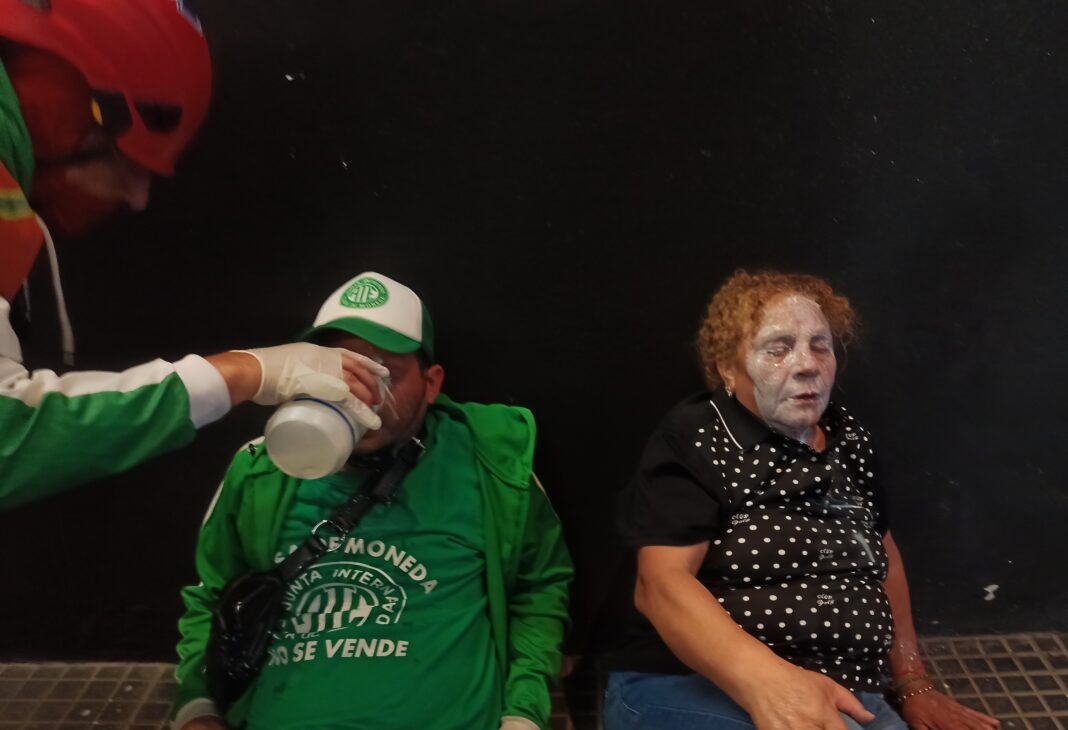Use of force, veiled censorship, and anti-protest protocols: Argentine democracy faces one of its most critical moments.
The shrill sound of loudspeakers at Constitución station echoes among the passengers: “By order of the Ministry of Security, any demonstration obstructing free transit is prohibited. Security forces will act in accordance with the law.” The pre-recorded message repeats like a mantra, but no one seems to listen.
Read: The Rights Denied to Black People in Argentina Under Milei’s Government
Outside, a line of police officers with shields and helmets guard the entrances. Just an hour ago, an elderly woman was dragged across the pavement while trying to reach Plaza de Mayo. Someone captured the moment on their phone: her trembling hands, the muffled scream, the blue uniform that shoved her without hesitation. The video is already circulating on social media under the hashtag #RepressedArgentina.

«If You Do the Crime, You Pay the Time»
President Javier Milei’s words flash on every screen: “The good guys wear blue, and the sons of bitches hiding behind rags and burning cars should be in jail.” But on the streets, the line between “good” and “bad” has blurred. Since December 2023, the anti-protest protocol and the deployment of tanks, tear gas, and rubber bullets have turned demonstrations into battlegrounds.
On March 12, Pablo Grillo, a 28-year-old photojournalist, was left with a fractured skull after being hit by a tear gas canister. While doctors fought to save his life at Fernández Hospital, Minister Patricia Bullrich accused him on national television: “He’s a Kirchnerist activist.” The image of Grillo bleeding on the pavement contrasts starkly with the cold official rhetoric.
«This Is Worse Than the Dictatorship»
Carlos Alberto, a 72-year-old retiree, leans his cane against a wall near Congress. His glassy eyes stare into the void as he speaks: “In ’76, they used to stop me with a rifle to my back. But now I can’t even leave my house without being asked for ID. This is bullshit!” Beside him, a young medic, Santiago Gutiérrez, tallies the day’s injured: “Over 300. Tear gas, rubber bullets, trauma… and a lot of fear.”
Unofficial figures speak of arbitrary arrests, elderly people beaten, and journalists threatened. Amnesty International has already raised concerns about the excessive use of force, but the government insists that “there is no repression, only order.”
Argentina, Between Memory and Resistance
Mercedes, a 38-year-old teacher, points to the fences surrounding Plaza de Mayo: “They spend millions on repression while retirees have to choose between food and medicine.” Her voice breaks as she recalls Beatriz, the elderly woman medics helped after being knocked down by a water cannon. “They’re taking away even our right to be outraged,” she says.
But in Argentina, memory both hurts and resists. Pedro, another retiree, smiles wryly: “Milei thinks he’ll break us, but Argentines are rebellious. The streets are non-negotiable.”
The Pulse Goes On
While the government insists the protests are “populist schemes,” universities, unions, and even artists are joining the movement. Former Security Minister Sabina Frederic warns: “We are one step away from losing constitutional rights.”
Yet on the street corners, where the white scarves of the Mothers of Plaza de Mayo mix with the flags of the youth, a clear message rings out: They won’t be silenced.
—“Aren’t you afraid of dying in the street?” someone asks Carlos Alberto.
—“Afraid?” he replies, adjusting his beret. “After everything I’ve lived through, this clown doesn’t scare me.”
Argentine democracy is still breathing, but the question remains: For how long?



